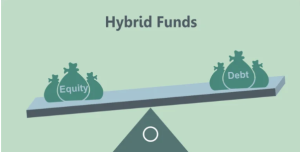
Hybrid funds, as the name suggests, combine investments in both equity and debt, offering a balanced approach to asset allocation. These funds aim to provide the growth potential of equity investments with the relative stability and income generation of debt instruments. Particularly for Indian investors seeking a diversified investment approach, hybrid funds, including the multi asset allocation fund, offer an attractive option. This article explores the intricacies of hybrid funds, highlighting how they balance risk and reward.
What Are Hybrid Funds?
Hybrid funds invest in a mix of asset classes, primarily equity and debt, in varying proportions. These funds are designed to reduce the volatility of an all-equity fund by adding debt securities to the mix, which generally offer relatively more stable and predictable potential returns. By adjusting the allocation between equity and debt, hybrid funds aim to offer a compromise between risk and potential returns, suitable for investors who prefer moderate growth potential with controlled risk exposure.
Key Features of Hybrid Funds
- Diversified portfolio: Hybrid funds provide exposure to both stocks and bonds, which helps in diversifying risk. The equity component aims for capital appreciation, while the debt portion offers relatively higher stability of capital.
- Dynamic asset allocation: Many hybrid funds adjust their asset allocation based on market conditions. This flexibility helps in managing the portfolio more effectively, potentially increasing returns during bullish markets and reducing losses during downturns.
- Automatic rebalancing: These funds automatically rebalance the holdings in the portfolio to maintain a consistent level of risk, saving investors the hassle of manually adjusting their asset allocation.
Benefits of Investing in Hybrid Funds
- Balanced risk and return: Hybrid funds offer a good balance between risk and return by combining the growth potential of equities with the relatively higher stability of capital of debt instruments.
- Suitability for various investment horizons: Whether for medium-term or long-term goals, hybrid funds can be appropriate because they can be tailored to different risk tolerances and time horizons.
- Convenience: Investing in hybrid funds is simpler and less time-consuming for investors than managing multiple separate portfolios of stocks and bonds.
When to Invest in Hybrid Funds
- Moderate risk appetite: A great alternative for investors with a moderate risk tolerance who want to enjoy the growth potential of equities but with reduced volatility. Hybrid funds are particularly suitable for those transitioning from debt-only portfolios who wish to enhance potential returns without the full risk of equity markets. These funds can serve as a gentle introduction to stock investments, providing a cushion against market downturns through their debt component. Additionally, they are perfect for retirement portfolios where maintaining capital is as crucial as growth.
- Looking for asset diversification: Investors aiming to diversify their investment across various asset classes through a single investment vehicle. Hybrid funds make it possible to invest in a mix of assets that might be difficult for individual investors to replicate on their own due to minimum investment requirements or complexity. This type of fund reduces the need to research and select multiple funds to achieve diversification, thereby lowering the risk and potentially enhancing returns through strategic asset allocation.
- Desire for simplified money management: Those who prefer a hands-off approach in managing their investments, relying on professional management to adjust allocations as necessary. Hybrid funds are managed by experienced fund managers who actively monitor market conditions and adjust the asset mix to optimise the risk-reward balance. This approach reduces the need for investors to keep track of individual investments and market trends, making it great for those with limited time or expertise in financial markets. Additionally, it allows for a set-it-and-forget-it investment strategy, which is appealing for busy professionals or those seeking to simplify their financial planning.
Multi Asset Allocation Funds: A Category Within Hybrid Funds
Multi asset allocation fund, a subset of hybrid funds, take diversification a step further by investing in more than just stocks and bonds. These funds may also allocate money to real estate, commodities, and other asset classes, providing a broader diversification and potentially higher resistance to market fluctuations.
Why Consider Multi Asset Allocation Funds?
- Enhanced diversification: By spreading investments across various asset classes, multi asset allocation funds reduce the risk of significant losses from any single asset class.
- Potential for higher adjusted returns: The inclusion of non-traditional assets like commodities or real estate can potentially enhance returns, especially in market environments where traditional stocks and bonds might underperform.
- Flexibility in response to market changes: The ability to shift between different asset classes gives these funds an edge in adapting to economic shifts, potentially maintaining steadier performance across different market cycles.
Conclusion
Hybrid funds, particularly multi asset allocation funds, offer a prudent investment choice for those looking to balance the potential high returns of equities with the relatively higher stability of debt. They are well-suited for investors who seek growth potential but are cautious about the volatility associated with pure equity funds. With their built-in diversification and professional management, hybrid funds can form a key part of a balanced investment strategy.
Before making any investment decisions, it is wise to consult with a financial planner or investment advisor to ensure these funds align with your financial goals and risk profile.
Mutual Fund investments are subject to market risks, read all scheme related documents carefully.











